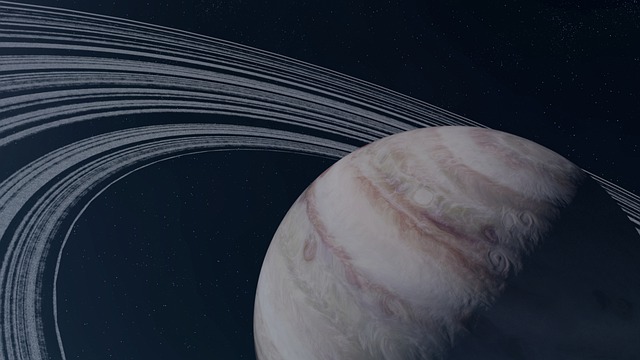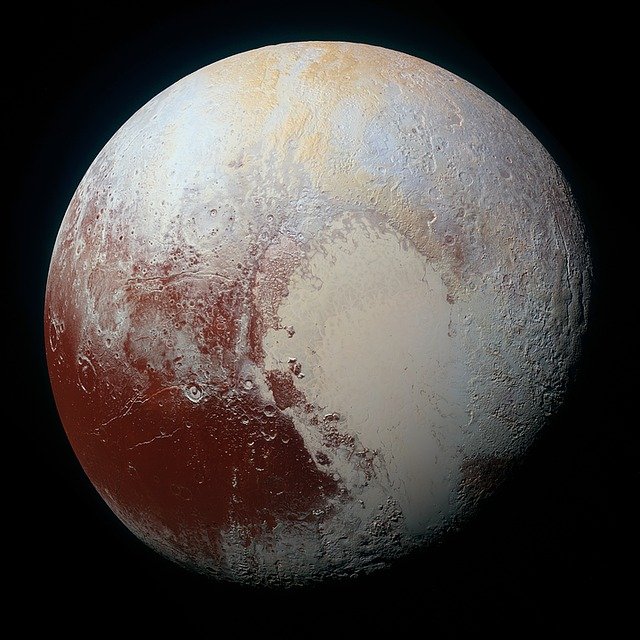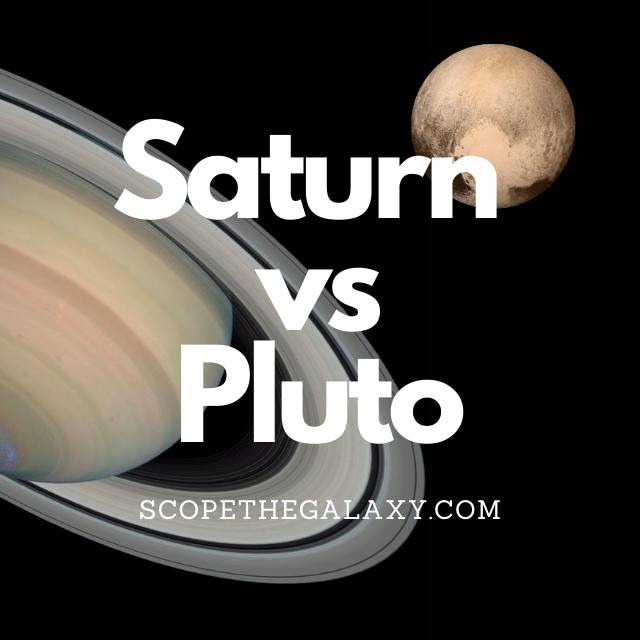*This post may contain affiliate links. This means we may make a commission if you purchase an item using one of our links*
The main differences between Saturn and Pluto is that Saturn is a gas giant whilst Pluto is a terrestrial dwarf planet, Saturn has 82 moons whilst Pluto has 5, Saturn is the 5th farthest planet from the Sun whilst Pluto is 9th, Pluto is tidally locked to its moon Charon whilst Saturn is not, and Saturn has 7 rings whilst Pluto has 0.
There are many other differences along with a few similarities between the two so continue reading for a more in depth analysis on both planets and a breakdown of any other differences.
What Is The Planet Saturn?
Table of Contents

Saturn is the second largest planet in our solar system that has 7 rings surrounding its gaseous exterior. It’s also the 6th farthest planet from the Sun.
As Saturn falls under the gas giant moniker, the planet is mostly made up of gases. However, Saturn’s composition is a little different from Jupiter’s where its atmosphere is a mixture of hydrogen and ices containing elements of Ammonia.
It’s core on the other hand is comprised of a dense core of nickel and iron, which is then surrounded by rocks compressed so strongly that it allows the planets core to reach scorching hot temperatures of 11,700+ degrees Celsius.
On the other hand, It’s gaseous atmosphere is far cooler. The exterior generally sits in the extreme sub zero range where Saturn’s temperatures averages around -138 degrees Celsius.
This is generally constant throughout the yellow ringed giants day to day. In fact it’s much colder than even the coldest place on Earth, which would be Eastern Antarctic Plateau, Antarctica that hits -94 degrees Celsius, which is more than 40 degrees Celsius warmer.
Being so large (116,460km), Saturn’s gravitational pull is obviously strong. That’s why over it’s 4.5 billion years of existence, beyond its rings, this yellow gas giant has managed to accumulate 82 different moons along with other smaller interstellar debris that now orbit it.
In fact it’s largest moon Titan is literally bigger than one of the 8 planets orbiting the Sun, Mercury.
Saturn also orbits the Sun but, as the 6th farthest planet from it, it does mean a singular orbit will take it 29.4 Earth years to complete. In comparison to its axial orbit which only takes 10.7 hours, this is exponentially longer.
What Is The Planet Pluto?

In the past Pluto was the 9th farthest official planet in our solar system however, in 2006 after many debates between astronomers, the International Astronomical Union officially downgraded it to a dwarf planet.
The reason for this downgrade at the time was primarily down to Pluto simply being too small when compared to every other planet and even the moons orbiting these planets. Pluto’s dwarf status is still debated to this day but, for now it remains under this dwarf bracket for a planet
Its diameter for example is only 2,370km, which is a third of Earth’s Moon. With that being said, despite the significant size discrepancy Pluto shows, it still does have more moon like objects orbiting it than Earth and I’m not saying just one more.
In total this terrestrial dwarf planet has 5.
Pluto’s atmosphere consists mostly of molecular nitrogen whilst molecules of methane and carbon monoxide have been observed also. As for its surface, it consist mostly of frozen nitrogen, methane, and carbon monoxide ices.
One of Pluto’s most unique characteristic is that Charon (its largest moon) is tidally locked to it and vice versa, which means that the two essentially orbit each other where, in essence only one side of Charon and one side of Pluto’s surface will face each other at any given time.
Pluto’s temperature is between -222 to -232 degrees Celsius based on how close it gets to the Sun when orbiting it, whilst its core temperature isn’t anything too special sitting around 500 – 1,000 degrees Celsius.
The main reason it’s as cold as it is and has a relatively cold core in comparison to the other planets would be mostly down to its size. A larger size would mean more mass could be compressed at the center which would produce more heat at the core.
Pluto’s orbit is also different from the other main plants in our solar system, following an elliptical orbital path as opposed to the circular path the others take. As a result of its distance from the Sun, Pluto will complete each one of these elliptical cycles around the Sun once every 247.78 years.
Even its rotational cycle is very slow, where one cycle is completed in 157 hours. Another interesting fact is the Pluto’s axial tilt is almost on its side at 57 degrees, similar to Uranus.
Similarities Between Saturn And Pluto
Saturn and Pluto have a few common features between themselves despite their various differences. They include the below:
- Both planets orbit the Sun.
- Both have a hotter central core.
- Both have multiple moons.
- Both are a spherical in shape.
Differences Between Saturn And Pluto
In regards to the differences between these two planets, they would include the following:
- Saturn has 7 moons whilst Pluto has 0.
- Saturn is a pale yellow color whilst Pluto is gray, brown and has elements of red and blue on its surface.
- Pluto has 5 moons whilst Saturn has 82.
- Pluto is tidally locked to one of its moons whilst Saturn is not tidally locked to any of its moons.
- Saturn completes an orbit around the Sun every 29.4 years whilst Pluto does so in 247.78 years.
- One day on Saturn is 10.7 hours whilst Pluto completes a single day in 157 hours.
- Pluto is the colder of the two where its temperature sits around -222 to -232 degrees Celsius whilst Saturn’s is around the -140 degrees Celsius mark.
- Pluto’s core temperature is 500 – 1,000 degrees Celsius whilst Saturn’s core is 11,700 degrees Celsius.
- Pluto is a terrestrial dwarf planet whilst Saturn is a ringed gas giant.
- Saturn is far bigger than Pluto with a diameter of 116,460km where Pluto’s diameter is 2,370km.
- Saturn’s gravitational and magnetic fields are far stronger than Pluto’s.
- Pluto’s orbital pattern is elliptical whilst Saturn’s orbital pattern is circular.
- Pluto’s axial tilt is 57 degrees whilst Saturn’s axial tilt is 27 degrees.
- Saturn has more mass than Pluto where it equates to roughly 5.683 × 10^26 kg as opposed to Pluto’s that is 1.309 × 10^22 kg.
Summary
Saturn is amongst the biggest gas giant planet in solar system whilst Pluto is a dwarf planet many millions of kilometers from it and more than a hundred times smaller.
Both are part of the same solar system and do orbit the same star, but from how they orbit their star, to their temperature and general composition, Saturn and Pluto come across very differently from and are just very distinct entities from each other.

